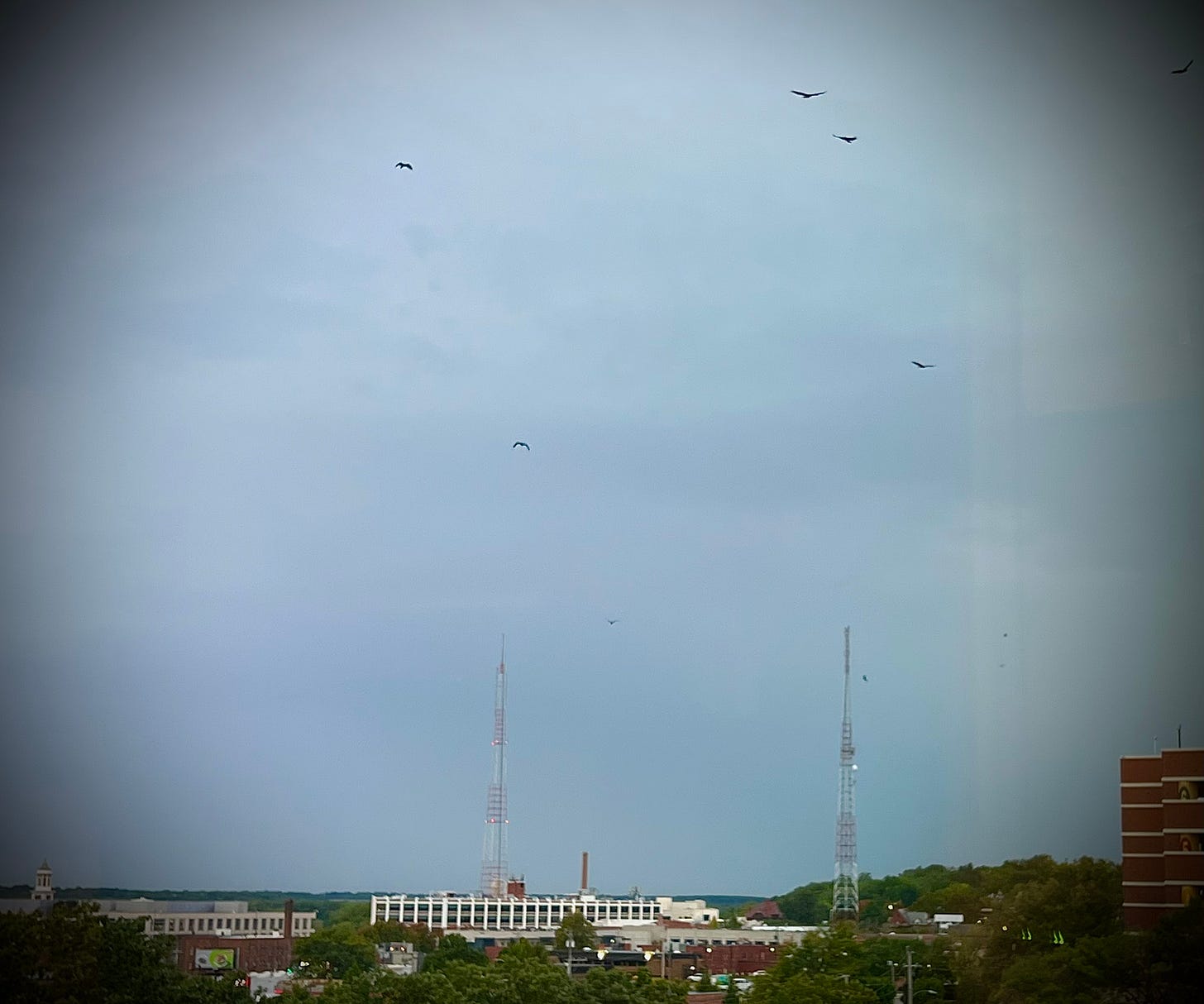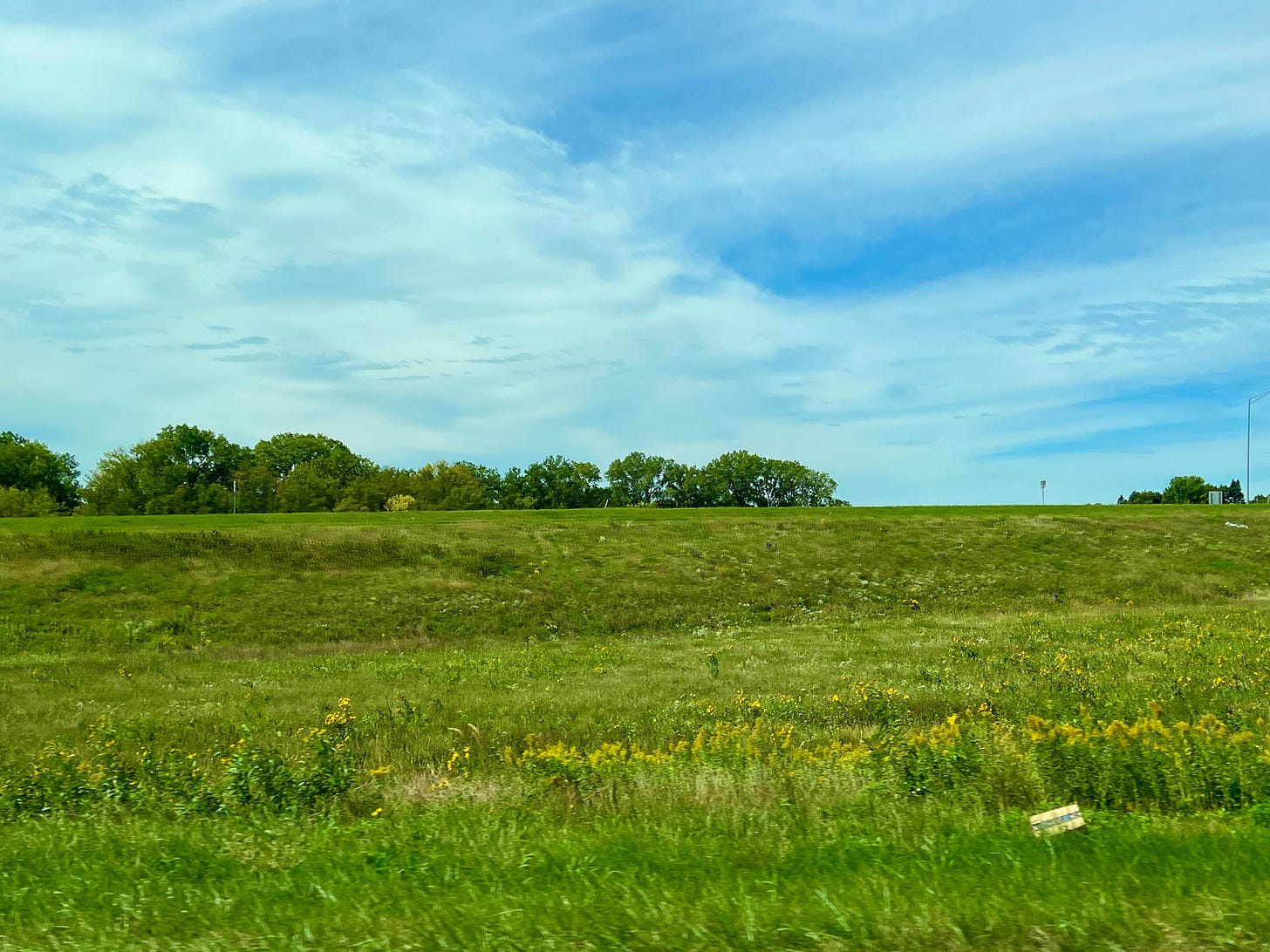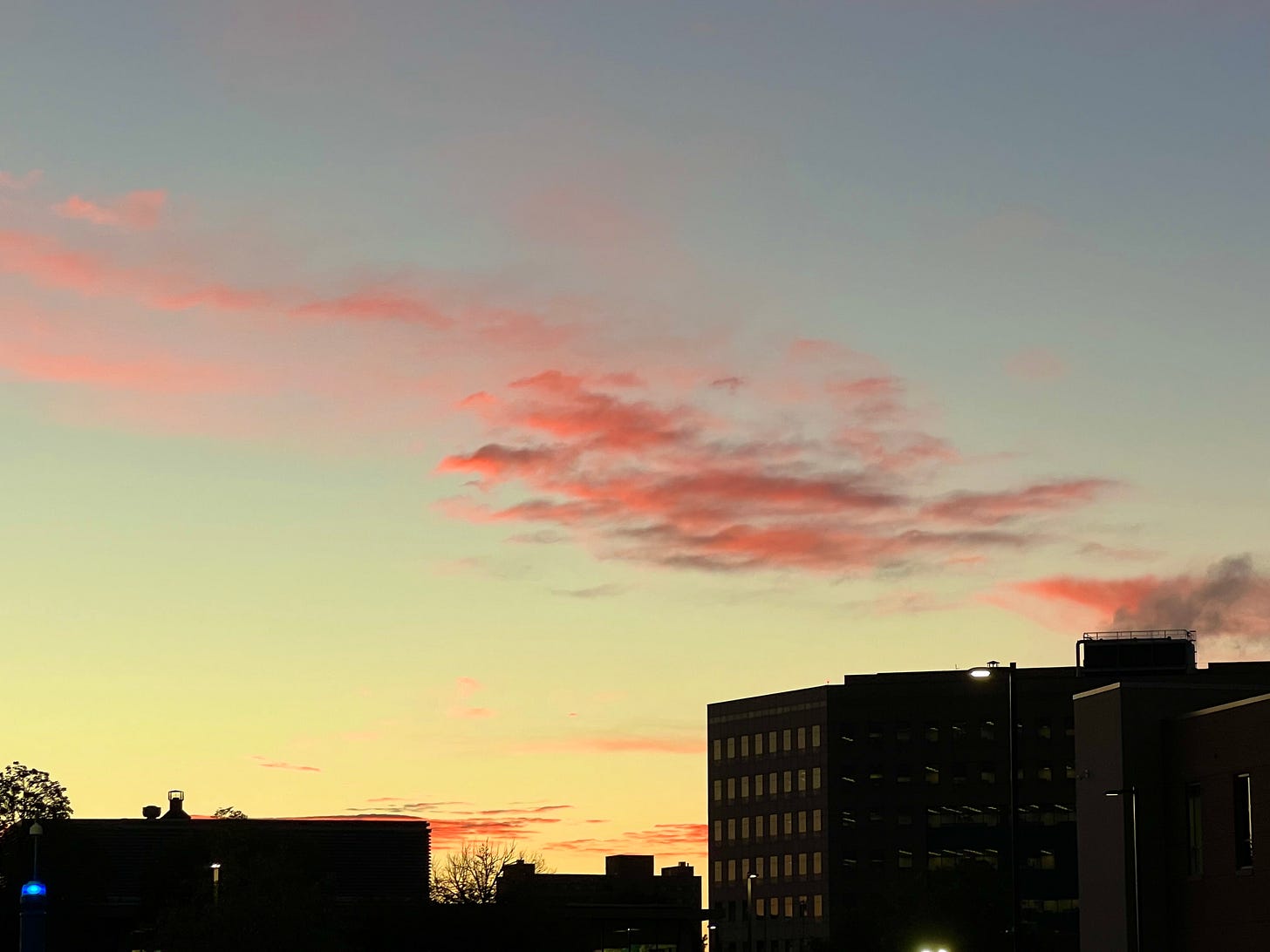The Natural History of Boring Postcards
When the light broke Friday morning outside the window of my dad’s hospital room, a dozen vultures were circling over downtown Des Moines, working their way slowly from the Raccoon River, over the old offices of the publisher of Better Homes & Gardens, and headed toward the medical center where we were encamped. Not a good omen when you are in the company of an 86-year-old whose replacement parts are starting to fail him.
Seven years ago I sat in that same hospital waiting to see if Dad would wake up after his open heart surgery, and I passed the time reading the corporate brochure that explained how the replacement valve was made of bovine peritoneum. Earlier that afternoon, the heart surgeon, a short and surprisingly wizardly man who wore a cap printed with images of hot chili peppers, told us how a healthy aortic valve looks like the wing of a dragonfly, whereas my dad’s looked like the foam insulation you spray in your attic. The image stuck with me, and the idea it nested, that the parts of our body are closely connected to other living things in nature, until we trash them.
When my mom and I walked back to the hotel at noon, the vultures were still there, prowling over downtown. In even bigger numbers, flying around the skyscraper of a major life insurance company, a post-modern tower of granite and steel that is the tallest building in Iowa. When I looked more closely, I saw that many of the vultures were perched on the balconies and ledges of the upper floors, where perhaps the senior executives could see them from their desks. And they say Des Moines is not cool.
Driving down to my parents’ home in the country sixty miles south of the city of actuaries, I remembered how it was on that same route after they bought that land in the late 80s that I first started noticing vultures over the interstate highways. Maybe they had always been there, or maybe it was an adaptation to some development of that era, like the end of the 55 mph national speed limit. The adaptation of vultures to urban environments seems more recent.
I have this old postcard in my office of Interstate 35 as it existed when I was a kid. Utilitarian American Autobahn, perhaps the most successful of the Nazi technologies we elected to adopt after the war, lined with tidily mowed ornamental grasses as it passes through the miles and miles of corn and bean fields, where a long century earlier there had been the biodiverse prairie and woodland that spanned the zone between the Missouri and the Mississippi. A landscape where everywhere you look it is green, but somehow there are no signs of real life.
When I was in college I always avoided the interstates, opting for the time travel of old highways, which seemed closer to the real. But now, as the vultures figured out, the interstates have been partially rewilded, the rights of way and medians re-seeded with native plants and the mowing mostly suspended. I made the hourlong drive between Des Moines and the Missouri border four times in two days, and everywhere you looked the goldenrod and sunflowers were in bloom against a bright green background. In some stretches of that drive the median expands into a thick, wet little forest, perhaps the bequest of some 1950s civil engineer. You wonder what terrestrial wildlife takes advantage of that micro-habitat. The hawks on the fenceposts and dead branches let you know there are furbearers there, even as the reports from DNR let you know how depleted every species but deer has been over the past century.
The place my parents retired to is an acreage of oak savanna in a part of Iowa where the farming has never been that good, such that these days the most profitable use of the land is preserves for rich Southerners to fly up and hunt bigger deer than they can find back home. My parents have been doing controlled burns on their place every year since they bought it in the 80s—my dad burned his eyebrows off during one of the early years—and the impact of that restoration effort is profound, and especially evident on the last day of summer. A forest of majestic old bur oaks reigning over a lush understory of wild plants, where forty years ago there was a mess of weedy trees on what had been used as rough pasture. Even in a brief run up and down the driveway in the middle of a trip busy with family crisis, you can experience the life that returns when you make room for it, and marvel at how well the native flora can reappear and reclaim the earth without a single seed being introduced by human hands.
On the morning of the autumnal equinox, I had to get up at 4 to drive back to the hospital in time to be there when the doctors made their morning rounds. When I stepped out to get to the car, the temperature had dropped into the low 50s after a surprisingly hot day the day before, and it was so insanely dark that I couldn’t see my own feet, and suddenly felt the instinctive danger of being out there. I heard a group of coyotes yipping in the near distance, and when I looked to the treeline I could barely even make it out. Just a dim sliver of light could be seen from the direction of the little town six miles away. The inky black of those woods reminded me how rare it is that we experience what night really is.
I was driving my dad’s old Suburban that morning, and when I got in it I found a Buzzcocks tape that my late brother had left in there, so I popped it in and found the deck still worked. Not the mellowest music for an early morning drive, but somehow it suited the moment, especially when the navbot routed me through an old country road at the edge of Des Moines that has been remade into a garish arcade of illuminated military signs, a “Veterans Parkway” that cuts through new subdivisions that have been built up between some of the last and best forest preserves in the county.
Maybe it was the tape that reminded me, as I parked in the visitors lot of the medical center as first light was breaking, that my brother’s last studio, in an old telecom building repurposed as artists’ lofts, had essentially the same view as my dad’s hospital wing. Every vantage a boring postcard, banal displays of everyday human ingenuity against a background of nature hiding in plain sight. A minimalist beauty you learn to develop an eye for growing up in such a place.
On the exterior facade of one of the back entrances to the complex, a designer had put coyote tracks into the concrete, maybe to entertain the children who sometimes have to enter that place. When I stopped to take a picture, I saw someone had left a barely-smoked cigarette there, as if they planned to return later and finish the job.
Flying back to Austin on Friday, I found myself thinking about the environmental costs of my trip, of the damage that is caused by the machines and systems that enable us to be with an ailing loved one across the country within hours of getting the news, and even of the technological systems we have developed to keep sick people alive. I was provoked in part by a new reader of this newsletter who wrote back last week, wondering if I consider such issues when I mention air travel in passing. I wrote a story once about a man who reads signs and portents in the contrails that lattice the sky at dusk, and in my last novel, a climate fiction, such transportation has been mostly banned, too late to do any real good.
The truth is you don’t need to be a fortune teller to know what future the contrails map. You could see it on final approach into Austin Friday evening, as a blood red sun burned through the increasingly hazy horizon of the fastest growing city in America, a place where the air rarely feels healthy. A less boring postcard, perhaps, but one that reveals more clearly the damaged atmospheric relationship we have with the star that is the real heart of our planetary habitat.
My wife and daughter picked me up, and as we walked up the path to the house, a pack of coyotes was yipping in the woods very close to our back fence. When I explained what the sound was to the three-year-old holding my hand, my daughter said to me that she is scared of coyotes, and as I reassured her that we were safe I also thought that’s probably a healthy instinct, even as I think wild canids in the city are mostly a healthy indicator. Children remind us of the dangers nature can pose, and help us try to imagine new ways to renegotiate the terms whereby we prevent the possibility of being some other creature’s food, without killing off all the animals that pose such a threat.
In the morning I heard an unfamiliar animal scream from the woods, even closer than the coyotes. A neighbor later suggested it must have been a raccoon, which made sense to me, having once been screamed at by their coatimundi cousins in a Central American forest. Then I remembered the strange bit of art that adorned the entry to our Des Moines hotel’s restaurant, a taxidermy raccoon covered in jewels.
The next afternoon as my daughter and I hung out in the living room, having a tea party with stuffed animals, I spotted a robin among the wild birds bathing at the edge of our pool. A bird that was among the most common of my Midwestern boyhood, but that I had never seen in Texas until two years ago, when they started appearing in these urban woods in winter. That they are back again, but now showing up months earlier, made me wonder what they know that we don’t. And whether they are better or worse omens than the vultures that have joined them in Des Moines.
Further reading
Boring Postcards is the title of a 1999 Phaidon art book compiled by the photographer Martin Parr from his collection of same. That book was of English postcards, and he published two more from his American and German collections: Boring Postcards USA and Langweilige Postkarten, the latter of which I gave to my brother as a gift when it came out in 2001. You can find excerpts from all three books on Parr’s website.
On the plane home, a link in an article about the recently announced census of the planet’s ants (20 quadrillion, or 2.5 million for every living human) got me reading this sobering 2018 NYT magazine piece by Brooke Jarvis, “The Insect Apocalypse is Here,” about the scientists who started paying attention to how there seemed to be fewer bugs in the air than when they were younger. A masterful piece of ecology journalism, it deals with more than the entomological angle of the trajectories it notes:
Anyone who has returned to a childhood haunt to find that everything somehow got smaller knows that humans are not great at remembering the past accurately. This is especially true when it comes to changes to the natural world. It is impossible to maintain a fixed perspective, as Heraclitus observed 2,500 years ago: It is not the same river, but we are also not the same people.
A 1995 study, by Peter H. Kahn and Batya Friedman, of the way some children in Houston experienced pollution summed up our blindness this way: “With each generation, the amount of environmental degradation increases, but each generation takes that amount as the norm.” In decades of photos of fishermen holding up their catch in the Florida Keys, the marine biologist Loren McClenachan found a perfect illustration of this phenomenon, which is often called “shifting baseline syndrome.” The fish got smaller and smaller, to the point where the prize catches were dwarfed by fish that in years past were piled up and ignored. But the smiles on the fishermen’s faces stayed the same size. The world never feels fallen, because we grow accustomed to the fall.
In the September issue of Harper’s, I read “Island Time,” an amazing piece by Rafil Kroll-Zaidi about trespassing John Travolta’s Maine retreat, the gentrification of the outdoors, and other things.
And in the Des Moines Register I picked up in the airport gift shop, I read the front page story about the sentencing of climate activist Ruby Montoya to six years in federal prison for vandalizing the Dakota Access Pipeline. The severity of the sentence evidently resulted from the judge’s finding that Montoya’s actions met the elements of the federal crime of terrorism, a remarkable conclusion based on the damaging of corporate property by a pair of activists who later held a press conference to reveal themselves as the culprits. My presumptions about the partisan politics behind this were proven wrong when I saw that the judge was an Obama appointee and the prosecutor appointed by Biden and Garland. Perhaps even more astonishing than the prison sentence was this penultimate paragraph:
“[Judge] Ebinger also ordered that Montoya and Reznicek pay nearly $3.2 million in restitution to Energy Transfer Partners.”
It made me wonder if perhaps centrist Democrats may be even more scared of real climate action than their GOP colleagues, and called to mind the provocative lede by James Butler in his November 21 LRB piece about Andreas Malm: “Where are all the ecoterrorists?”
The Register piece on Montoya’s sentencing is behind the paywall, but here’s a similar report from WHO-TV, and a much deeper profile at Grist.
*Thanks to the stranger who kindly and clandestinely paid for my lunch in the Des Moines airport, after, as I later learned, seeing me give up my table seat for another solitary traveler.
Have a rowdy week. Field Notes may be off next weekend, depending on whether any more hospital visits are in order for your correspondent.












The arteries of interstate highways may be the source of regenerated life amid the infection of industrial agriculture that has bathed Midwest land in herbicides and anhydrous fertilizer, and of course chemical-laced livestock manure. After we are gone.
Driving between KC and Lawrence about a thousand times in the early 90s, a trip crossing the border in the form of the Missouri River, a stretch of I-70 feels like a neighborhood street to me in many ways. The numbers on bridges in Kansas like numbers on mailboxes.